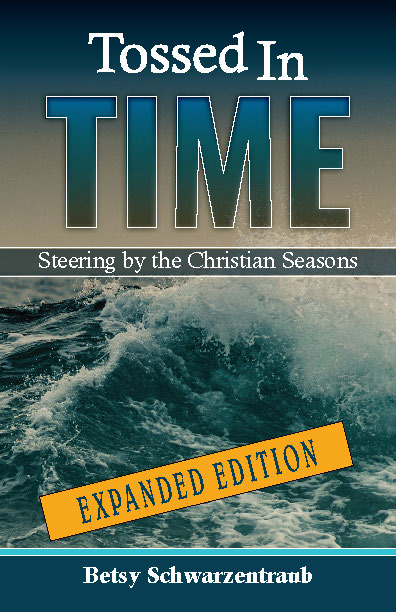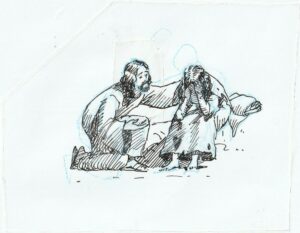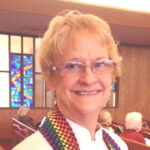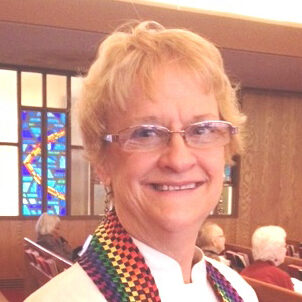Tossed In Time Expanded Edition:
Steering by the Christian Seasons
By Betsy Schwarzentraub

Navigating your boat through the storm
Living beyond the first tumultuous waves of the COVID-19 pandemic, we may still feel as if a multi-dimensional storm has rushed down on us. The sense of meaningful movement through time can be overwhelming. Casting about for a trustworthy guide in the discomfort and confusion, we can look to a different way of counting our days. The Christian Calendar provides a sense of meaningful movement through time and gives us a foundational rhythm for our days.
♦♦♦♦♦
The Tossed in Time Expanded Edition introduces people to the ancient Christian seasons to help them find their personal bearings in the midst of the isolation and social disruptions of recent years. It gives a new rhythm to begin again, engaging a broad readership with down-to-earth themes, reflective questions, and fun home activities. This Expanded Edition provides interactive workshop ideas to experience each season in the home, church, or private school setting. Line drawings throughout the book remind us that Jesus is as accessible to us now as he was to his followers back in biblical days.
Excerpt from Tossed In Time Expanded Edition:
Steering by the Christian Seasons
Finding Our Bearings
The Christian Year
All year long
PETER REFLECTS ON THE STORM:
Most everyone has to deal with chaos at some time in their lives. It’s easy to lose our bearings in the middle of it. If I’m out fishing and it’s a clear night, I can steer by the stars. But there are plenty of times when storm clouds conceal them. And life onshore can be even harder to navigate sometimes.
When I have the courage to look for Jesus somewhere out in the middle of the trouble, it helps. My life may seem to go down the drain in lots of ways, but if I look straight at what’s going on, I might see what the God of Israel is doing in the middle of the tumult. So is there any framework that can help me be at home with God, even in the midst of all that commotion?
♦♦♦
What if there were a different kind of calendar to mark our days, to help us remember what’s really important?
I grew up assuming that everyone goes by one calendar. The year begins in January and ends in December. It never occurred to me that a calendar could be anything different. As an adult, I saw that Jewish months have different names and start at different times. I also felt the Jewish calendar was full of spiritually significant days. Later, when our family expanded, I learned that Muslims use different months and have other names, also based in religion. Then I discovered that a lot of the names for months and days in my familiar calendar, like January and Sunday, come from names the ancient Romans gave to their gods!
So what is the Christian calendar?
Theme 1: A Different Calendar
The calendar used in parts of the world influenced by a European heritage comes from a kaleidoscope of viewpoints and traditions. The Christmas cycle, for example, starting with Advent and going through Epiphany (November through February) is based on the non-Jewish (“Gentile”) calendar. Wherever the ancient Romans went, they brought their way of keeping time with them. Key dates in that calendar stay the same from year to year, such as December 25 for Christmas Day. But the Easter cycle, starting with Lent and going through Pentecost (late March or April through early November) is based on the Jewish calendar and follows the movements of the moon.

Together, these two cycles give Jesus followers a primary rhythm year after year, regardless of social holidays and other celebrations in the wider community. Both cycles are bracketed by hope. In the first cycle, Advent is on the front end, with hope in the birth of Jesus Christ on Earth. On the back end of that cycle is Epiphany: hope in the Good News of God’s love going out to all the world. Then in the second cycle, on the front end there’s Lent: the promise of new beginnings through divine forgiveness. And on the back end is Pentecost: hope in Christ’s final coming at the end of time. It’s not that we need to go around living day to day with the end times in our mind. But for those who choose to notice the worship seasons, there is both unity and balance.
For several years, I trained people to become volunteer pastors of congregations. A portion of that teaching dealt with the Christian Year. One of the most creative and exciting things I’ve done to teach the Christian Year was with worship leader Carol Kern, who is an extraordinary church musician and visual artist.
The project involved refrigerator boxes.
It offered participants a walk-through experience. Carol went to appliance stores and picked up the huge cardboard containers in which the stores received refrigerators. That was a win-win, since they were going to throw out the boxes anyway. When standing up, the containers were at least five and a half feet tall.
We left one side of each box open and then painted both the insides and the outsides of the boxes with the season’s color: purple for Advent and Lent, white for Christmas and Easter, green for Epiphany, and red for the day of Pentecost and green for the ordered days that follow it. Then we added seasonal sayings and borrowed worship banners from churches to drape over the top of the open box panels. Finally, we made or found various symbols related to each season, using the five senses. A circle of candles surrounded the Christ candle for Advent, recorded Christmas carols allowed visitors to sing along at Christmas, fragrant frankincense recalled the coming of the wise men in Epiphany, and so on. Every person had a handout sheet with things they could do at each station, including questions to ponder.
Theme 2: Two Cycles
I first saw a colored chart of the worship seasons long before doing the workshop with Carol. It was composed of two half-circles of color, divided horizontally, with each half moving from purple on the left, through white in the center, to green on the right. The first color was purple for Advent, next white for Christmas, then green for Epiphany. Beneath that half-circle came purple for Lent, white for Easter, then a sliver of red for Pentecost Day and green for the rest of the Pentecost season.
Seeing the year this way, the two purple seasons of Advent and Lent are times to prepare by turning our lives back toward God. During Advent, the four weeks before Christmas Day, we can slow down to reflect on our lives, admit our brokenness and need for healing, and actively wait for the One who seeks to come more deeply into our lives. Then in the second half of the year, Lent does the same thing before Easter. If we’re struggling with our own failings, feeling vulnerable and broken, or mourning those we have lost, the worship seasons remind us of the One who ultimately overcomes all suffering and separation.
The white periods of Christmas and Easter in the second stage give us cause to celebrate. Multiple days of Christmas remind us that the Creator of the cosmos comes alongside us, into every part of human life. The Easter season reveals Jesus’ victory over death on our behalf, offering a radiant way of living both now and beyond death. Both seasons give us many days to praise God’s goodness and claim our joy.
Then in the third, green stage of Epiphany and Pentecost, we respond with “So what do I do now?” Do I dare to live, not with easy answers, but with a fuller trust in God? Is there a way I can conduct my daily life that better expresses the Good News of forgiveness and new beginnings? How can I help change the destructive systems in which we live, or at least help heal the hurt that they cause?
Technically, this green stage includes what church scholars call “Ordinary Time,” but the word “ordinary” can be misleading. It does not mean ho-hum, run-of-the-mill days. The term is related to the word “ordinal,” meaning “coming in order.” Ordinary time is when many of our common Scripture readings present some Books of the Bible from the beginning to end over successive weeks, to share the unique message of that particular biblical writer. For most Christians around the globe, it is clearer and simpler to identify those “ordered” days with the seasons of Epiphany and Pentecost to which they relate. That is what I chose to do in this book, as well.
Now the worship year is portrayed as one big circle instead of two halves. Currently there are about 2.3 billion Christians worldwide. Two billion of them are part of the “Western Church.” It includes most of the Catholic Church, Western Protestant denominations around the globe, and their offshoots. For these Christians, the circle of the Christian Year begins in Advent and comes all the way around to Pentecost, which leads into Advent once again.
There are many reasons to imagine the year as a circle. Throughout human history, the circle has been a universal symbol, most often representing wholeness, original perfection, timelessness, and cycles of movement. In Chinese culture, the Tai Chi circle stands for harmony, balancing yin and yang: the mixture of two energies that make life possible. People have also seen the circle as a symbol for God, who is at the center of everything and has no circumference. For Native Americans, the traditional sacred circle stands for the four seasons, the universe, and the cycle of life.
So how does the full circle work for the Christian Year? As author K.C. Ireton says, its cyclical nature gives us “repeated opportunities to live out various aspects of our faith, to see life through the lens of the Christ-story and to deepen our understanding of what it means to be a follower of Jesus.”1
So we recall the circle of the seasons as it moves through two cycles:
- Advent: preparing for Christ’s coming more deeply into our lives – Christmas: celebrating Jesus as Emmanuel, God With Us – Epiphany: seeing the Light of Christ in the world.
- Lent: taking stock of our lives and getting back on track – Easter: the mystery of Christ, who has defeated death – Pentecost: living with God’s Spirit active in our lives.
Theme 3: The Difference the Christian Year Can Make
Time makes a big difference for an anchored life. For example, Dietrich Bonhoeffer (1906 – 1945) was a pastor, professor, theologian, anti-Nazi activist, and key founding member of the “Confessing Church” that opposed the Nazi regime. He was clear about the distinction between personal faith and institutional religion and had seen the complete failure of the German Protestant church in the face of fascism.
Bonhoeffer was arrested by the Gestapo in 1943 and thrown in prison. Accused of participation in an exposed plot to kill Hitler, he was eventually taken to Flossenburg concentration camp. There he was hanged just two weeks before U.S. soldiers liberated that place of suffering and death.
All the time he was in prison, Bonhoeffer wrote letters, sermons, and Christian papers, which his family and sympathetic guards passed on to the outside world. His Letters and Papers from Prison includes more than two hundred writings.
 Locked away from every social connection he had ever known, Bonhoeffer could tell time only by remembering the Christian worship seasons and special days throughout the year. That was how he marked time: remembering parts of hymns and memorized prayers, encouraging or worshiping with other prisoners when allowed some moments together, and praying for people and circumstances in the wider world. In that way he kept tethered to the continuity of worship and prayer under the defining story of Christ.
Locked away from every social connection he had ever known, Bonhoeffer could tell time only by remembering the Christian worship seasons and special days throughout the year. That was how he marked time: remembering parts of hymns and memorized prayers, encouraging or worshiping with other prisoners when allowed some moments together, and praying for people and circumstances in the wider world. In that way he kept tethered to the continuity of worship and prayer under the defining story of Christ.
By keeping his worship bearings, Bonhoeffer was able to know where he was in that Nazi storm. As a result, his life and writings continue to exert a huge influence on Christians across broad denominations and ideologies, from religious conservatives to non-affiliated liberals, from the Civil Rights movement in the United States to the anti-Apartheid movement in South Africa and anti-communist movements in Eastern Europe. His enforced “sheltering in place” did not keep him from his purpose and from meaningful living.
Questions:
- What days do I want or need to remember as I look forward to the year ahead? What would I like to research in order to celebrate those dates in a more significant way? Are there other people I would like to include in those remembrances or celebrations?
- What would help me be more mindful of the worship rhythms of my life? Where in my home could I put something to represent each worship season as it arrives?
- How could I prepare for Christmas and for Easter in a more thoughtful way? How might that different kind of preparation affect the way I, or we, mark those events at home?
Things To Do:
- Set up a candle on your dinner table to repeat a phrase each season. For example, today you might say:
Candlelighter: “Giver of both time and eternity,”
All at the table: “my life is in your loving hands.”
- Write down the essential dates you want to remember this year. What birthdays or anniversaries? What natural seasons? Look at the first page of each of the chapters on the seasons in this book, then put the first day of each worship season in your calendar. As you read about that time in this book, consider one thing you might like to do to pay more attention to its themes in your life.
- Read Matthew 14:22-33 for yourself. Imagine what it must have been like that day at the feeding of the five thousand, then when Jesus’ followers were sent off in the boat, and finally through that long, fearful night. What stands out the most about those events? What would all of that have been like for you? Start a personal journal or try a poem or a picture showing one of those scenes.
- Create your own smaller version of the seasonal refrigerator boxes by using a file folder for each worship season. When decorated, it can stand on a table in your home. Use water-based paint to do the background color, then make or find symbols of the season that invite engagement. Cut out pictures from magazines or elsewhere that reflect the themes of the season. They are listed as themes in each chapter of this book and also on the worship cycle charts of the “Worship Arts” workshop in the appendix.
Let family members help you put the stand-up folder together. Have a Bible there to read any related verses. Talk with one another about the significance of the season. Take a picture of your creation, so you can remember the experience and do something different with that same season the following year.
- Arthur Gafke’s book Pray the Seasons: Pastoral Prayers for Seasons of the Year and of Life, offers refreshing prayers related to both the Christian Year and the secular calendar. Look through this or another resource that gives you some words for everyday communication with your Creator.


